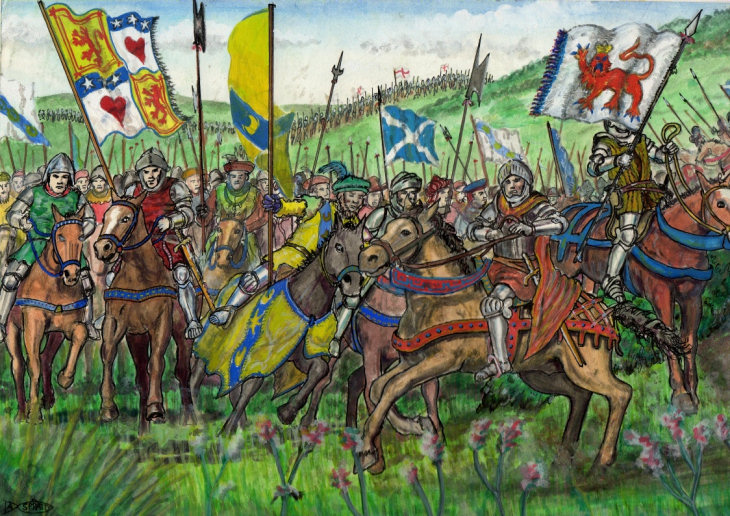|

Image by Andrew Spratt
1545 (17/25/27 Feb) Ancrum Moor (or Ancram)
se St Boswells, Roxburgh
Archibald, Earl of Angus bt Sir Ralph
Evers/Evre & Sir Brian Latoun/Laiton/Layton
The Battle of Ancrum Moor was part of Henry VIII’s campaign known as the
Rough Wooing. The objective was to force the Scots to accept a marriage
between Henry’s son Edward and the infant Mary, Queen of Scots. While
raiding in the Borders, the English army was attacked by a Scottish force at Ancrum Moor, just outside Jedburgh. The English were defeated in the battle
and suffered heavy losses, including the deaths of two senior commanders.
The victory of the Scottish force ended the English raiding for a
time and, in the wake of the defeat, France sent troops to help the Scots
attack England. However, in the event no major campaign was launched, as the
Scottish Regent, the Earl of Arran, feared provoking the English king into
further attacks. In the longer term, the defeat at Ancrum Moor ultimately
lead Henry to escalate his military action against Scotland, cumulating in
the catastrophic defeat of Scottish forces after his death at the Battle of
Pinkie in 1547.
The Battle
The English army consisted of 3,000
mainly German mercenaries, 1,500 English Borderers and 700-800 Scottish
‘assured men’ (Borderers who had sworn allegiance to the English crown).
They had been at Melrose and were on their way back south towards Jedburgh.
Having seen a small Scottish cavalry troop moving from Peniel Heugh hill
back to the north-west, the English army turned back to pursue them. The
English appear to have been divided into two battles. The vanguard was led
by Layton and consisted of around 2,000 spearmen, hagbutters (men carrying a
portable long-barrelled gun) and archers. The second battle was led by Eure
and consisted of around 3,000 men. Both battles had spears in the centre and
one wing of archers, the other of hagbutters. What they did not know was
that the Scots comprised a force of around 2,500 men including Fife lances
and Border Reivers, accompanied by cannon.
The English attacked uphill, thinking that they were attacking a
small body of cavalry. However, the main Scottish army came over the brow of
the hill and pushed the vanguard back into the rest of the English army. As
the situation deteriorated for the English army, the ‘assured men’ ripped
off the red crosses that marked them out and attacked the English troops as
well; this betrayal by the ‘assured men’ was subsequently blamed as the key
factor for the English defeat. The English lines collapsed and a rout began.
Both Layton and Eure were killed, along with up to 800 of their army;
prisoners were numbered at around 1,000.
Events & Participants
The battle involved the Scottish Regent, James Hamilton Earl of Arran, and
Archibald Douglas Earl of Angus. Arran was next in line to the Scottish
throne after Mary, and was instrumental in negotiating the betrothal of Mary
to Francis, the French dauphin.
The Douglas and Arran never trusted each other, and their
differences led to a massive defeat the following year at Pinkie.
|
|


